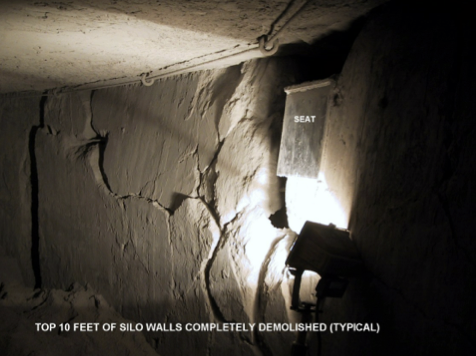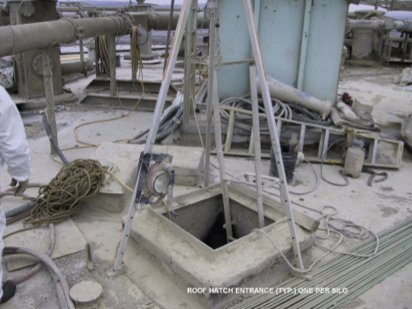Project Perspective
Cement Silo Roof Repair - New England
The owners and operators of a cement manufacturing plant in New England became very concerned in 2000, and even more so in 2001 when numerous large sections of concrete and entire 36 inch steel roof beams began appearing in the coned bottom cement discharge chutes, having fallen from the roof interiors of the storage silos.
Unique Projects
Knowles Industrial Services, specializing in concrete roofing repair, was retained to perform an internal inspection with operations personnel in order to determine the cause and propose a concrete repair solution. It was determined that significant damage was occurring on the uppermost levels of the cast-in- place concrete walls, and beam seats that support the silo roof. In some units, the 7-ton steel I beam roof supports were becoming dislodged from their beam pockets.
A roof failure was simply not something that could be allowed to happen, as these silos were the only ones available for storage of manufactured Types I and II cement. A roof failure would shut down operations entirely, resulting in cement shortages, lost profits and lay-offs of personnel.
A fast tracked schedule, paired with winter conditions, harsh working environment, safety risks,and difficult access made for a unique problem, requiring custom concrete solutions. The complexity of the work required a dedicated team of professionals working closely together with the owner to resolve these issues.
The Principles Involved Included:
Engineer/Architect: Knowles Industrial Services Corporation, Gorham, Maine
Shelley Engineering, Westbrook, Maine
Project Manager: Andrew H. Lawson
Site Supervisor: Wallace Stetson
Project Period: November, 2002 to April, 2003
Total Project Value: $350,000.00
Since 1927, this plant has been producing high quality cement for industry. It is the only cement manufacturing facility in New England that produces Types I, II, and III cement, as well as Type S and N for the masonry market. When the finished product (dry cement powder) is ready for the bulk market, it is stored in one of several clusters of very large reinforced concrete silos. Thirty-six years ago, one such group of silos was constructed as an interconnected bank of six 32 foot diameter by approximately 200 foot high silos with facilities that allowed a rail car or tank truck to drive through and be bulk loaded from underneath.
These silos were simultaneously constructed using the slip-formed method in one non-stop process of pouring the concrete while continuously jacking the forming system at a rate of about 4 inches in elevation per hour during the 24-hour a day pour. Once full height is reached, the steel jacking beams used to support the forming system were left in place and became the roof support beams which rested in beam pockets in the concrete walls at roof level. The first step was to pour one continuous reinforced concrete roof slab that covered all six silos supported by the steel roof support beams below.
During the last four years, operations had reported large pieces of reinforced concrete coming out of the discharge chutes below and, in two instances, steel roof beams themselves that had to be cut into in small sections and using a torch removed by hand. The product was being contaminated by water leaking in around the damaged beam pockets, creating quality control problems. During the filling operations, cement dust was escaping at the faulty seals around the beam pockets, creating an environmental hazard.
Plant engineering personnel were closely monitoring the situation. They had even called Knowles Industrial Services on two occasions to perform inspections and comment on causes and repair scenarios. The damage was the result of vibrations and high air pressure caused by drawing cement out of the bottom. Densely packed cement was exhibiting arch effect support for the cement above it, causing large voids for subsequent avalanching.
Time was of the essence. A recent increase in demand for the types of cement stored in these silos and safety issues surrounding concrete debris falling into work areas on the outside perimeter made it necessary for the owner to immediately address the problem by hiring a concrete repair contractor. Knowles Industrial Services proposed a solution and was awarded a negotiated contract to effect repairs during the plant’s slower production season when the owner could afford to forfeit the use of one silo at a time.
Innovations in Construction Technique
The uniqueness of this repair, tight schedule, and customer’s cost awareness made an easy case for serious brainstorming at the Portland office. Many very clever approaches for different aspects of the concrete repair process were developed to offset the known constraints.
An innovative combination containment/work platform was devised, allowing us to stand and work directly from the top of the cement in the silo which was held down to approximately 8 feet from the underneath side of the roof slab. A solution allowing a worker to stand directly on top of the cement would prevent them from from miring dangerously deep in the loose powdery cement. This innovation allowed us to cut 4 weeks off the overall schedule, which would normally have been reserved for building swing staging. In addition, the owner did not have to deal with the financial hardship of greatly lowering the levels of cement in the silos.
There was no reasonable way to replace the 6-ton W-36 I-beams that had previously fallen, but they had to be replaced to provide for proper roof support. These large beams had already been installed before the cast-in-place roof was constructed. In addition, it would have cost between $30,000.00 and $50,000.00 to mobilize a crane large enough to rig the beams. Knowles Industrial Services decided to design an equivalent reinforced concrete beam to replace it, since all the necessary materials could be brought down the hatch.
Shelley Engineering of Westbrook, Maine was retained for the design and the result was a direct cost savings to the owner of approximately $30,000.00. It would have cost a lot more if we had been forced to find a method to even get a steel beam in the silo and jack it up into position. Wet shotcrete structural repairs on the walls saved a significant amount of time and money versus what it would have taken to form, pour, and strip all of these areas.
A unique combination of “jacking and lifting” beams back into intimate structural contact with the underneath side of the slab was developed using high strength 1 inch rods, plates and 10-ton bottle jacks. This minimized our rigging and kept the necessary roof penetrations very low where the constant threat of water contamination on the cement below was ever present.
Challenges of this Unique Job
1. Access is always a significant factor in determining the ultimate success of any project. This was especially true at Thomaston. Aside from the obvious difficulties created by working a height of more than 200 feet, some of the not so obvious challenges included the following:
All materials had to be hand carried to the roof level using a very small, relatively slow moving personnel elevator.
All efforts (including material) had to be conducted through a 2-1/2 foot by 2-1/2 foot opening on each silo using full confined entry procedures.
All construction debris generated had to be brought back down using the same elevator.
All rapid set wet mix shotcrete materials had to be pumped up to the roof through a small 1 inch hose at a record breaking 220 foot vertical lift during temperatures at which a system plug could have caused the material to freeze in the lines within minutes.
The roof work area at 200 feet was subjected to high coastal winds at near zero temperatures (wind chill of 80° to 100° below 0°) greatly impacting how things got done safely and efficiently, especially the hole watch for confined entry.
Efforts to not contaminate 5,000 tons of new cement directly under us was a detail that demanded constant attention. Absolutely no construction debris, tools, materials, or water could be allowed to drop into the cement headed for market.
2. Accurate schedule projections of when a silo was going to be complete were necessary to avoid downtime, since it could sometimes take weeks to lower the cement level in our next silo. Coupled with this with their varying demand for Type I, II or III cement, it turned scheduling into more of an art form rather than a task.
3. Cement dust was a constant enemy. The slightest disturbance dislocated dormant dust, allowing it to penetrate air tools, radios, filters, PPE and make work a constant hazard from many perspectives.
Environmental Perspectives
This manufacturer has always been a champion in ensuring that their operation has minimal impact on the environment, surrounding community, and Maine coastline. To this day, dust control has, is, and always will be a critical component of their environmental plan. Capturing and recycling cement kiln dust back into the process, quarry dust control and process containments all do their part to control this problem.
During silo filling operations, cement dust was escaping the silo containment through the damaged perimeter beam pockets which were open to the atmosphere. Our efforts provided a seal to prevent this from occurring. Operating as designed, the silos are now providing properly contained storage and promoting steady, uninterrupted plant operations. A major roof incident would have caused a formidable environmental challenge to address.
Contribution to Community
This plant has been an important integral part of the local economy for almost 80 years, employing upwards of 500 people at times and providing assistance and support to numerous civic and local organizations. We hope that our efforts to assist in critical plant maintenance and our ideas to accomplish this using very cost effective means, will go a long way towards ensuring that the plant continues to be an integral part of the community.
Our repair methods allowed for completed repairs without any labor lay-offs to the local work force which depends heavily on this plant for well-paying jobs. In addition, we maintained a policy of buying construction supplies locally whenever possible.
Responsibilities to Client Needs, Customers Satisfaction
We believe that in all business climates, owners need to take advantage of every opportunity to keep costs down by finding innovative methods to solve a problem and bring their goods to market at the lowest possible cost. The owner made it clear during the contract negotiation, that costs and safety were big concerns and they were depending on us to complete the work as competitively as possible. That included utilizing on-site facilities such as their machine shop to fabricate beam seats and other miscellaneous metals whenever it made sense, working as close as possible with operations to minimize silo downtime and proper planning to avoid overtime.
We achieved these goals as is evidenced by our completion of the work $30,000.00 under budget and ahead of schedule without any lost time accidents. Following our efforts, there have been no further silo issues.
In addition, we have alleviated the urgency of the roof instability problem from their daily concerns, thus allowing them to continue to focus on what they do best, provide a high quality product to their market at a competitive price.
For more information on this project, contact the Knowles Engineering Group.






